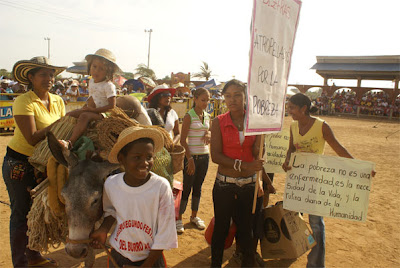
Love him or hate him– and there appears to be no standing on the fence here– Bush’s best buddy in South America has increased security, dealt some serious blows to the guerrillas, presided over economic growth, and encouraged tourism into a “conflict zone.”
Did you know that Colombia, in stark contrast to its Latin American counterparts, has only suffered one coup d’état and one dictatorship in its history, way back in 1953…although the students hollering out there in the streets would have you believe that current boss is no better than a dictator.
Whisper it carefully and in well-chosen circles, but the FARC and ELN Guerrilla groups are possibly at their lowest ever ebb.
2. Fading FARC Influence
Controversial events such as the rescue of Ingrid Betancourt and the three American contractors from the southern jungles of Guaviare, as well as the deaths of leading FARC members Raul Reyes, Ivan Rios, and founding member Manuel “Tirofijo” Marulanda, have led many commentators to declare FARC a tired anachronism.
3. The conflict is not aimed at you.
Cocaine and kidnapping. Sure, cocaine and marijuana are regularly available, and your decision to meddle in the marching powder is what keeps Colombia’s warring factions in business.
As for kidnapping, unless you are an aid worker attached to an international NGO, a crusading journalist or just plain crazy, why would you be traveling alone through the forests of Guaviare, Vaupes, or other outlying regions where there is the very real threat of being kidnapped?
4. Reputable Bus Firms
Overland travel, even at night, with reputable bus firms between the major cities of Bogota, Cartagena, Medellin, Santa Marta and intermediary cities such as Barrancabermeja, Bucaramanga, Ibague, Manizales, Villavicencio has become acceptable and frequent.
5.US State Department Warnings
Come on! If you were to follow these to a T then you would never leave the prairie. Apply some common sense and listen to what the locals have to say; after all, this is not Baghdad.
6. Secure Urban Areas
Walk around Bogota’s Zona T and Zona G or Medellin’s El Poblado and see how lightly the Colombians themselves are taking life. Some 15 years ago you would have thought twice and then thought better of a night out here in Medellin, but now it’s how to stay in and detox that is the main concern.
7. Colonial Cities
For small perfectly preserved whitewashed and cobblestoned oases of calm, make your way to Popayan, Mompos, Villa de Leyva, and San Gil.
Cartagena is a little more frenetic and plagued with street vendors but then it’s been receiving tourists for decades.
8. Tourism is booming
But don’t let this put you off; come now before the rest of the world catches on. Cartagena and Bogota are still the most visited areas of the country, closely followed by Medellin, but what does it tell you that a country with a long running internal conflict received a little more than two million visitors in 2007?
9. Colombians
War weary and decidedly unhappy with their narco-fueled image as perceived by those only glued to Fox News will have you believe – are arguably the friendliest bunch in the Americas.
If you’re lost In Brazil, a local will show you home. But in Colombia you’ll be invited to the family cookout that day or the following!
10. Still Afraid?
In this case you are advised to head only to the Colombian Caribbean islands of San Andres and Providencia – as they say over there, “no hay guerrilla maritima,” “there’s no sea-based guerrilla!” Grab a coco loco and hit the beach.













